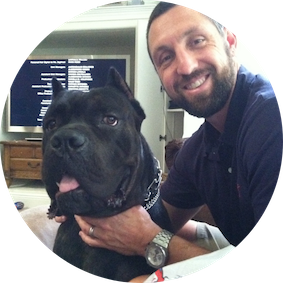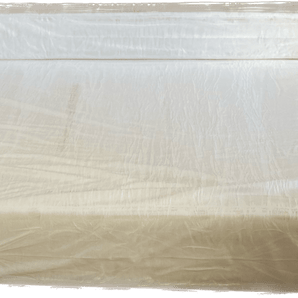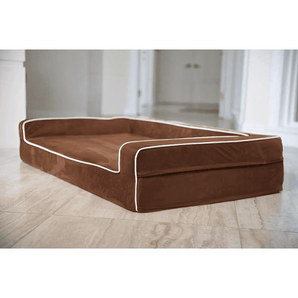The American Bully often surprises people. You see a stocky, powerful dog with a broad head and serious muscles, then you meet one and realize they’re sweet, affectionate, and happiest curled up next to their family. Many first-time dog owners confuse them with the American Pit Bull Terrier or other bull breeds, but the American Bully is a distinct breed that was developed for companionship and a stable, people-focused temperament. Their look may be tough, yet their personality is soft around the edges.
If you’re considering an American Bully or you already share your home with one, this guide walks through everything you need to know. We’ll talk about their structure, their temperament, and the kind of day-to-day care that keeps them healthy. Since this breed can be heavy-bodied, we’ll also look at ways to support their joints and make life more comfortable at home.
American Bully Breed Overview and Characteristics

Physical Traits and Types
The American Bully packs a lot of power into a compact shape. They have a blocky head, a deep chest, and a muscular frame that gives them a strong presence. Their upright shoulders and heavy bone structure create that signature silhouette seen across the bully breed community.
Even next to other dogs in the terrier breeds or bull breeds (such as the American Pitbull Terrier), the American Bully stands out. The official UKC breed standard emphasizes balance, strength, and confidence, along with normal movement and sturdy rear legs.
You’ll usually see four size categories:
-
Standard: A medium size with balanced proportions and a confident look.
-
Pocket: Shorter dogs with the same overall structure and physical characteristics.
-
XL: Known for larger frames and extra body mass. XL Bully dogs draw attention thanks to their size and solid build.
-
Classic: Similar to the Standard but with less overall body mass and more traditional features that lean toward older parent breed influences.
While the breed is known for its solid physique, some traits fall outside the breed standard. Bowed legs, cow hocks, flat feet, narrow hindquarters, long toes, and overly round eyes are considered serious faults, according to the United Kennel Club. A fused tail, docked tail, gay tail, and sickle hocks may also signal a structure that doesn’t match the standard. These variations appear more often in mixed breeds or lines that blend in American Bulldog or English Bulldog traits.
Temperament and Personality
Even with their strong build, American Bully dogs shine through with a calm, steady personality. They love being close to their people and tend to be excellent companions for families with kids. Many owners describe them as great family pets, and it fits. They enjoy attention, they’re patient with children, and they bond tightly with their household.
Aggressive behavior goes against the breed standard. Extreme shyness and dog aggression are discouraged as well. With early socialization, American Bully dogs get along with other animals, other dogs, and strangers without issue. Introduce them to new environments, sounds, and people while they’re young. This helps them grow into confident adults who stay relaxed during new experiences.
Specialized Care and Health Management

Joint Health and Structural Support
One of the biggest health considerations for the American Bully comes down to their structure. That heavy body mass and wide chest look impressive, yet they increase stress on their front legs, rear legs, shoulder blade, upper arm, and hips. Hip and elbow dysplasia are common concerns, and many dogs develop arthritis earlier in life if they don’t have the right support.
Something as simple as daily rest can affect long-term mobility. A supportive orthopedic dog bed keeps their weight evenly distributed and reduces pressure on their joints. Our Bully Bed was made with large, muscular dogs in mind and offers a comfortable, durable surface for rest and recovery.
Dogs who wake up stiff or slow to stand often benefit from this kind of support. Over time, good bedding helps with normal breathing, normal movement, and overall comfort.
Diet and Nutrition
Feeding an American Bully takes a little thought. They need a balanced, high-protein diet that maintains muscle without pushing their weight into unhealthy territory. Their structure works best when they stay lean, since extra pounds put more tension on their joints and can lead to issues like legs crossing, rear legs moving awkwardly, or shifts in posture.
Your vet can recommend formulas that support muscle health, skin integrity, and immune function. Many American Bully dogs respond well to diets with vitamins, minerals, and antioxidants that support recovery after regular exercise. Keep treats in moderation and measure out meals to maintain a healthy size, especially for growing XL American Bullies who can put on weight fast.
Grooming and Skin Care
The American Bully has a short, smooth coat that’s easy to care for. A quick brushing once a week with a rubber mitt keeps shedding under control and spreads natural oils for a glossy shine. They don’t need frequent baths, but when you do bathe them, use gentle shampoo and rinse thoroughly.
Skin sensitivity can be a recurring theme for this breed. Some dogs develop allergies, eczema, or hot spots, especially in warm climates. Keep an eye on common trouble spots like the belly, paws, and any folds. Dogs with protruding eyes or round eyes may need more regular eye cleaning. Traits such as blue eyes, nose turning, or long coat sometimes show up in mixed breeds but do not reflect the breed standard.
Training, Socialization, and Exercise

Training Philosophy
If you want a dog who loves training, the American Bully is a great match. They respond well to positive reinforcement and enjoy learning simple tricks and cues. Praise, play, and food rewards motivate them without adding stress. Consistency makes a big difference, since this breed thrives on clear expectations and routine.
Harsh corrections tend to shut these dogs down. Stick to patient, encouraging guidance. You’ll see faster results and a happier pup, especially with dogs in the larger XL Bully category who rely on calm, structured leadership.
Essential Exercise
Daily activity keeps the American Bully healthy and balanced. They need regular exercise to maintain their muscle and stay mentally satisfied. A couple of brisk walks or a play session in the yard usually does the job. Trips to dog parks can be fun, but go during calmer hours until you’re confident in how your dog interacts with other dogs.
Some American Bully dogs have shorter muzzles and may struggle with heat. Warm weather can make breathing harder for them, especially if they have features similar to the American Bulldog or English Bulldog parent breed. Aim for cooler parts of the day and bring water everywhere you go.
Preventing Destructive Behavior
Chewing is common with this breed. Puppies chew to soothe their gums, and adults chew when they’re bored. Provide toy rotation and interactive games to keep their mind busy. Mental stimulation often tires them out faster than physical activity.
If you have a dog who chews anything they can reach, you’ll want a bed that can handle a little abuse. Our Chew Proof Dog Bed was designed with heavy chewers in mind and stands up to tough jaws.
It’s a helpful option for owners who want durable gear that can keep pace with their bully dog’s habits.
Major Health Risks to Monitor

Joint and Bone Issues
Hip and elbow dysplasia appear often in bully dogs. Early exams help you track growth and catch problems before they affect mobility. Puppies who show signs like flat feet, narrow hindquarters, or unusual gait patterns should be evaluated early.
Heart Disease
Some American Bully lines carry congenital heart conditions. Routine checkups give you a straightforward way to monitor changes.
Brachycephalic Concerns
Dogs with shorter muzzles may overheat quickly or show signs of limited airflow. Loud breathing, nighttime snoring, or trouble in hot weather can be early indicators. These traits appear more often in mixed breeds or dogs that resemble the American Bulldog or English Bulldog.
Eye Conditions
Issues such as cherry eye and entropion appear in several American Bully bloodlines. Dogs with protruding eyes often benefit from regular cleaning to avoid irritation or infection.
Hearing Issues
Unilateral or bilateral deafness has been documented in several bully breed lines. Most dogs adapt well with proper training and a bit of patience from their owners.
Bite and Dental Concerns
Some dogs show a wry bite or other dental irregularities. These issues may not affect daily life but are worth discussing with a vet or breeder. A healthy mouth keeps your American Bully comfortable as they age.
Investing in Your Bully’s Best Life
The American Bully offers a mix of loyalty, strength, and warmth that makes them stand out among other dog breeds. They thrive in homes where they get steady attention, early socialization, and regular exercise. Add in balanced nutrition, joint support, and routine checkups, and you set them up for a long, comfortable life.
Giving your American Bully the right foundation makes a big difference. A supportive orthopedic bed, patient training, and smart weight management all work together to protect their joints and keep them moving well into adulthood. Talk with your veterinarian about their growth, health plan, and any breed-specific concerns you should watch for.





